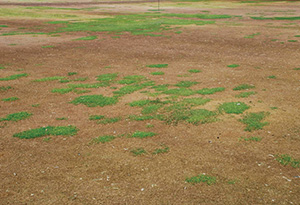Creeping bentgrass vs. annual bluegrass during cold deacclimation

Differences in winter survival of annual bluegrass and creeping bentgrass following a mid-winter warming event. Photo: Xian Guan, Michelle DaCosta, Ph.D., and Scott Ebdon, Ph.D
Turfgrass deacclimation during winter and early spring can negatively impact freezing tolerance, leading to winter injury. Superintendents managing mixed stands of annual bluegrass (Poa annua) and creeping bentgrass (Agrostis stolonifera), have often observed differences in winter injury susceptibility of these two species. This may be attributed to differences in their ability to resist deacclimation in response to winter warming. To improve winter survival of annual bluegrass in northern climates, a better understanding of the physiological factors that contribute to freezing tolerance and deacclimation sensitivity is needed.
The objectives of this study were to compare the freezing tolerance of annual bluegrass and creeping bentgrass during cold acclimation and deacclimation and to examine changes in carbon metabolism during deacclimation. Plants were removed from the field and progressively exposed to the following treatments in a growth chamber: non-acclimated control at 68°F; cold acclimation at 36°F; cold acclimation at 28°F; and deacclimation at 46°F. Changes in freezing tolerance were determined based on lethal temperature resulting in 50 percent kill (LT50). In addition, carbon metabolic activities were monitored based on canopy photosynthesis and respiration rates, along with chlorophyll fluorescence parameters.
Overall, creeping bentgrass exhibited higher freezing tolerance following cold acclimation and maintained higher freezing tolerance during deacclimation compared to annual bluegrass. Photosynthesis, respiration and photochemical yield of annual bluegrass increased more rapidly during deacclimation. This suggests that metabolic and physiological activities of annual bluegrass were activated earlier in response to warmer temperatures. Although rapid up-regulation of carbon metabolism may provide annual bluegrass with a competitive advantage during spring recovery, these responses may also lead to greater susceptibility to freezing injury in response to mid-winter warming. Research is currently underway to understand additional factors that may be responsible for differences in deacclimation sensitivity between annual bluegrass and creeping bentgrass.
Xian Guan, Michelle DaCosta, Ph.D., and Scott Ebdon, Ph.D., University of Massachusetts. Michelle DaCosta can be contacted at mdacosta@umass.edu for more information.








